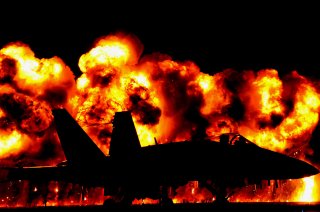The U.S. Marines Need These 5 Weapons to Crush North Korea in a War
It would be a bloody affair.
In the event of a conflict on the Korean Peninsula, U.S. and South Korean forces will root and and destroy the regime of Kim Jong-un. The need to properly secure the country’s weapons of mass destruction will necessitate an invasion of North Korea, much of which will come by sea. Leading the way will be the U.S. Marine Corps (USMC). Here are five USMC weapon systems necessary in Korean War II.
1 - Amphibious Assault Vehicle
Any seaborne landing by the Marine infantry will involve Amphibious Assault Vehicles (AAVs). First introduced in the early 1970s, AAVs carry up to twenty-one marine infantry and their equipment. Their amphibious nature means they can float out of the well deck of a U.S. Navy ship such as Wasp-class assault ships, swim to shore on their own power and disgorge troops on the beachhead. Alternately, it can use its tracks to transport infantry farther inland.
Recommended: Could Iran Sink a U.S. Aircraft Carrier?
AAVs are capable of traveling up to eight miles an hour in the water and up to forty-five miles an hour on land. They are lightly armed, typically carrying both a 40mm grenade launcher or .50 caliber machine gun. AAVs are lightly armored, at best capable of repelling 14.5mm machine gun fire or artillery shrapnel. This, combined with their large troop carrying capacity makes them vulnerable on the modern battlefield.
Recommended: 5 Reasons No Nation Wants to Go to War with Israel
2 - MV-22 Osprey
Modern amphibious assaults move marines as much by air as by sea. Aircraft can move faster and farther than AAVs and landing craft, even landing miles away from the nearest beachhead. This vastly increases the amount of terrain enemy forces must actively defend.
Recommended: How North Korea Could Start the Unthinkable: War Between America and China
A MV-22 Osprey tiltrotor aircraft can take off and land vertically like a helicopter, rotate its engine nacelles ninety degrees forward, and fly like a conventional aircraft. This gives it the best advantages of both types of aircraft, all the while carrying up to twenty-four combat-ready Marines, support weapons, supplies or vehicles. The Osprey has a top speed of 277 miles an hour, making it a third faster than helicopters in its weight class. It has range of up to 500 miles—or much more with midair refueling.
In a North Korea scenario a marine air assault force led by MV-22s would land a force miles from the enemy beachhead, presenting the enemy commander with the dilemma of which landing to respond to. After a securing the beachhead MV-22s could lead the way, leapfrogging from one landing zone to another, the enemy not knowing if it intends to land five or five hundred miles away.
3 - CH-53E Super Stallion
Until an amphibious invasion force seizes an airfield or port, reinforcements and supplies will have to come in via helicopter. While the MV-22 Osprey can transport infantry, it’s limited in the size and weight of the cargo it can carry.
The CH-53E Super Stallion, the largest helicopter in U.S. military service, is capable of carrying a sixteen-ton load, fifty-five marines or any combination thereof. The helicopter has a typical range of 500 miles, but heavy loads cut that down considerably. Fortunately it has a midair refueling probe, giving it almost unlimited range.
The USMC uses Super Stallions to haul heavy equipment, particularly artillery and LAV-25 light armored vehicles from U.S. Navy ships at sea to a secure airhead. The helicopter is also used to move casualties off the battlefield to medical facilities on navy ships.
4 - LAV-25
The Light Armored Vehicle, or LAV-25 is a eight-by-eight armored vehicle that mounts a 25mm M242 Bushmaster cannon. The vehicle can carry up to four scouts to conduct armed reconnaissance missions. The LAV-25 is unique in being capable of landing by sea via LCAC hovercraft, under its own power via waterjet propulsion, or by CH-53 heavy lift helicopter. LAVs are assigned to USMC armored reconnaissance battalions and variants include antitank, command and control, mortar, logistics carrier and recovery versions.
The LAV-25’s combination of firepower and portability makes it dangerous foe for those opposing an amphibious invasion. The LAV-25 can arrive by sea or air, and once on location it can quickly roll out to perform armed reconnaissance missions. LAV-25s were recently upgraded to the standard which included LAV-25A2 included improved armor protection, improved suspension, a new fire suppression system, and a new thermal imaging system for the commander and gunner.
5 - High Mobility Armored Rocket System (HIMARS)
The acquisition of the HIMARS rocket system in the mid-2000s gave marine artillery a big boost. HIMARS takes the proven 227mm rocket system from the U.S. Army’s tracked MLRS system and puts it on a five-ton truck, providing a firing platform for up to six rockets (or one jumbo-sized ATACMS rocket) at a time.
HIMARS can be quickly moved ashore via Landing Craft Air Cushion hovercraft, and within minutes can carry out precision fire missions to ranges of up to forty-three miles. The Gimler, or Guided Multiple Launch System - Unitary (GMLS-U) GPS-guided rocket allows HIMARS to engage targets with first round precision. Recently, the marines experimented with chaining HIMARS trucks to the flight deck of amphibious assault ships, providing invasion troops with their own long range, extremely precise naval artillery support.
Kyle Mizokami is a defense and national security writer based in San Francisco who has appeared in the Diplomat, Foreign Policy, War is Boring and the Daily Beast. In 2009 he cofounded the defense and security blog Japan Security Watch. You can follow him on Twitter: @KyleMizokami.
Image: Flickr.

